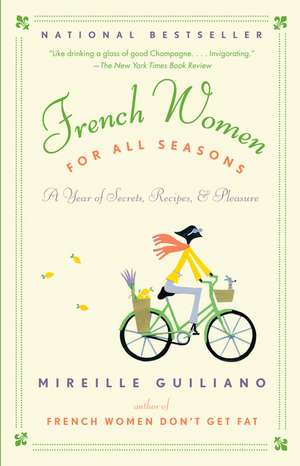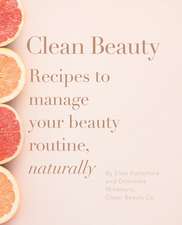French Women for All Seasons: A Year of Secrets, Recipes, & Pleasure
Autor Mireille Guilianoen Limba Engleză Paperback – 31 mar 2009
Together with a bounty of new dining ideas and menus, Mireille Guiliano offers us fresh, cunning tips on style, grooming, and entertaining. Here are four seasons' worth of strategies for shopping, cooking, and exercising, as well as some pointers for looking effortlessly chic. Taking us from her childhood in Alsace-Lorraine to her summers in Provence and her busy life in New York and Paris, this wise and witty book shows how anyone anywhere can develop a healthy, holistic lifestyle.
| Toate formatele și edițiile | Preț | Express |
|---|---|---|
| Paperback (2) | 59.55 lei 24-35 zile | +22.78 lei 4-10 zile |
| Vintage Publishing – 3 mai 2007 | 59.55 lei 24-35 zile | +22.78 lei 4-10 zile |
| Vintage Books USA – 31 mar 2009 | 107.46 lei 3-5 săpt. |
Preț: 107.46 lei
Nou
Puncte Express: 161
Preț estimativ în valută:
20.57€ • 21.24$ • 17.12£
20.57€ • 21.24$ • 17.12£
Carte disponibilă
Livrare economică 04-18 martie
Preluare comenzi: 021 569.72.76
Specificații
ISBN-13: 9780375711381
ISBN-10: 0375711384
Pagini: 359
Ilustrații: ILLUSTRATIONS THROUGHOUT
Dimensiuni: 127 x 201 x 23 mm
Greutate: 0.25 kg
Editura: Vintage Books USA
ISBN-10: 0375711384
Pagini: 359
Ilustrații: ILLUSTRATIONS THROUGHOUT
Dimensiuni: 127 x 201 x 23 mm
Greutate: 0.25 kg
Editura: Vintage Books USA
Notă biografică
Mireille Guiliano is the internationally best-selling author of French Women Don't Get Fat (2004) ands its companion French Women for All Seasons (2006), which have appeared in thirty-seven and twenty-three languages respectively. She is also a pioneer in business as a longtime senior executive at the world's largest luxury goods company, LVMH Moët-Hennessy—Louis Vuitton, where among other things she brought trendsetting marketing innovation to Champagne Veuve Clicquot. She has written widely on food, wine, travel, and lifestyle for a range of international publications.
Extras
Pears with Chocolate and Pepper
Serves 4
The pear is one of nature's most remarkable inventions; its versatility is second to none. What other fruit could wed so perfectly with chocolate one minute, blue cheese the next?
Zest of 1 orange
2/3 cup sugar
4 Bosc pears
2/3 cup heavy cream
4 ounces dark chocolate, coarsely chopped
1 tablespoon unsalted butter, cut in small pieces
Freshly ground pepper
1. Bring 1 quart water, the orange zest, and the sugar to a boil. Peel and core the pears, keeping them whole by cutting the core out from the bottom, and put them in the boiling syrup over low heat for 20 minutes. Place each pear on a dessert dish and let cool.
2. Bring the cream to a boil, then pour in the chocolate and stir to melt it. Whisk in the butter piece by piece. Pour the sauce over the pears and season with pepper to taste. Serve immediately.
N.B. Pepper is surprising with dessert. It enhances the flavor of fresh fruit. In my first book, I included a pineapple dessert. You can also use pepper with strawberries.
Ouverture
“It was the best of times, it was the worst of times.” Thus Charles Dickens began his Tale of Two Cities a century and a half ago. The cities he imagined were Paris and London. The countries he was contrasting were revolutionary France and late-eighteenth-century England. Two opposing worlds, two points of view. And two divergent destinies. When I wrote French Women Don’t Get Fat, I had in mind two disparate worlds of eating: the French and the American. Also, to a lesser extent, two cities, Paris and New York. What I did not realize at the time was that I was in fact writing a tale of two global cultures increasingly without borders. For better and worse, where you live no longer dictates how you eat. It’s up to you.
Even in our ever more complex world, it is still possible to have our cake and eat it too, to enjoy our days to the fullest in many ways while embracing a time-tested, back-to-basics approach to life–one filled with quality, sensitivity, seasonal foods, and pleasure. I don’t want to live in the past, but I do want to learn from it, and I believe that the culture of moderation, painstaking attention to taste, and healthy eating and living that I absorbed growing up in France can be adapted to today’s world and pursued just about anywhere. This is not to say I don’t understand or appreciate firsthand the challenges women these days face: the pressures of too much to do in too little time, of mega portions and industrially produced food often eaten on the run.
For a long time, this clash of cultural and lifestyle perspectives and outcomes took shape in my mind as a contrast between on the one hand fundamental elements of French culture and on the other behaviors I learned in America. But with the appearance of French Women Don’t Get Fat in language after language, I have come to understand that what I thought of as a national divide is really only an emblem for a conflict of two world orders. While I certainly don’t think I have all the solutions to this conflict, or any highly specialized expertise–I try not to take myself too seriously–I still have more experiences and secrets (and many more recipes and weekly menus) to share that will help people enjoy a better quality of life–and almost certainly lose weight.
Last fall a French reporter followed me through the Union Square Greenmarket in New York, where we encountered a class of eight-year-olds with their teacher. The kids were participating in a program called Spoons Across America, a not-for-profit organization dedicated to educating children, teachers, and families about the benefits of healthy eating and the value of supporting local farmers and sharing meals around the family table. As it was fall, apples of many varieties were abundantly available. But when the reporter, half kidding, picked one up and asked a little boy what it was, the child drew a blank. Forget the variety; he did not know it was an apple. This city kid had apparently never seen one in real life. It gives one pause. I would bet, though, that he could recognize the packaged apple pie at the McDonald’s just opposite the greenmarket.
The world where I grew up–and my experience of apples–in Alsace-Lorraine could not have been farther from this little boy’s in New York City. As I recall it, all our neighbors had at least one fruit tree, and we had numerous apple trees in our garden. Come apple-picking time, my job was to place the different varieties we grew into little flat crates called cagettes, which we put into the cold cellar for winter storage–a centuries-old practice now mostly gone. What sweet and glorious aromas filled that cellar when I deposited all those baskets! (Tellingly, in French the word for smell, sentir, also means feel.) Today I recall the apple smell even more powerfully than the old footage of that autumn ritual I carry around in my head. And, of course, the harvest meant my mother would once again make an apple pie, une tarte aux pommes alsacienne.
In our garden we also had bushes of groseilles, tart red currants that are a regional specialty. My mother and I loved to make pies with these tiny berries. The season for red currants is short, and we quickly made jam (confiture) or jelly (gelée) or pies, and sometimes a sauce (coulis). And oh, how we looked forward to this once-a-year treat, which somehow exemplifies for me the French woman’s psychological pleasure in food. It is the anticipation and joy that we gain from a pleasure we cannot take for granted and know we will soon lose. Tasting such seasonal bounty heightens our awareness of what we put into our mouths and contrasts with routine, mindless eating that provides little pleasure and often unwanted pounds.
From the Hardcover edition.
Serves 4
The pear is one of nature's most remarkable inventions; its versatility is second to none. What other fruit could wed so perfectly with chocolate one minute, blue cheese the next?
Zest of 1 orange
2/3 cup sugar
4 Bosc pears
2/3 cup heavy cream
4 ounces dark chocolate, coarsely chopped
1 tablespoon unsalted butter, cut in small pieces
Freshly ground pepper
1. Bring 1 quart water, the orange zest, and the sugar to a boil. Peel and core the pears, keeping them whole by cutting the core out from the bottom, and put them in the boiling syrup over low heat for 20 minutes. Place each pear on a dessert dish and let cool.
2. Bring the cream to a boil, then pour in the chocolate and stir to melt it. Whisk in the butter piece by piece. Pour the sauce over the pears and season with pepper to taste. Serve immediately.
N.B. Pepper is surprising with dessert. It enhances the flavor of fresh fruit. In my first book, I included a pineapple dessert. You can also use pepper with strawberries.
Ouverture
“It was the best of times, it was the worst of times.” Thus Charles Dickens began his Tale of Two Cities a century and a half ago. The cities he imagined were Paris and London. The countries he was contrasting were revolutionary France and late-eighteenth-century England. Two opposing worlds, two points of view. And two divergent destinies. When I wrote French Women Don’t Get Fat, I had in mind two disparate worlds of eating: the French and the American. Also, to a lesser extent, two cities, Paris and New York. What I did not realize at the time was that I was in fact writing a tale of two global cultures increasingly without borders. For better and worse, where you live no longer dictates how you eat. It’s up to you.
Even in our ever more complex world, it is still possible to have our cake and eat it too, to enjoy our days to the fullest in many ways while embracing a time-tested, back-to-basics approach to life–one filled with quality, sensitivity, seasonal foods, and pleasure. I don’t want to live in the past, but I do want to learn from it, and I believe that the culture of moderation, painstaking attention to taste, and healthy eating and living that I absorbed growing up in France can be adapted to today’s world and pursued just about anywhere. This is not to say I don’t understand or appreciate firsthand the challenges women these days face: the pressures of too much to do in too little time, of mega portions and industrially produced food often eaten on the run.
For a long time, this clash of cultural and lifestyle perspectives and outcomes took shape in my mind as a contrast between on the one hand fundamental elements of French culture and on the other behaviors I learned in America. But with the appearance of French Women Don’t Get Fat in language after language, I have come to understand that what I thought of as a national divide is really only an emblem for a conflict of two world orders. While I certainly don’t think I have all the solutions to this conflict, or any highly specialized expertise–I try not to take myself too seriously–I still have more experiences and secrets (and many more recipes and weekly menus) to share that will help people enjoy a better quality of life–and almost certainly lose weight.
Last fall a French reporter followed me through the Union Square Greenmarket in New York, where we encountered a class of eight-year-olds with their teacher. The kids were participating in a program called Spoons Across America, a not-for-profit organization dedicated to educating children, teachers, and families about the benefits of healthy eating and the value of supporting local farmers and sharing meals around the family table. As it was fall, apples of many varieties were abundantly available. But when the reporter, half kidding, picked one up and asked a little boy what it was, the child drew a blank. Forget the variety; he did not know it was an apple. This city kid had apparently never seen one in real life. It gives one pause. I would bet, though, that he could recognize the packaged apple pie at the McDonald’s just opposite the greenmarket.
The world where I grew up–and my experience of apples–in Alsace-Lorraine could not have been farther from this little boy’s in New York City. As I recall it, all our neighbors had at least one fruit tree, and we had numerous apple trees in our garden. Come apple-picking time, my job was to place the different varieties we grew into little flat crates called cagettes, which we put into the cold cellar for winter storage–a centuries-old practice now mostly gone. What sweet and glorious aromas filled that cellar when I deposited all those baskets! (Tellingly, in French the word for smell, sentir, also means feel.) Today I recall the apple smell even more powerfully than the old footage of that autumn ritual I carry around in my head. And, of course, the harvest meant my mother would once again make an apple pie, une tarte aux pommes alsacienne.
In our garden we also had bushes of groseilles, tart red currants that are a regional specialty. My mother and I loved to make pies with these tiny berries. The season for red currants is short, and we quickly made jam (confiture) or jelly (gelée) or pies, and sometimes a sauce (coulis). And oh, how we looked forward to this once-a-year treat, which somehow exemplifies for me the French woman’s psychological pleasure in food. It is the anticipation and joy that we gain from a pleasure we cannot take for granted and know we will soon lose. Tasting such seasonal bounty heightens our awareness of what we put into our mouths and contrasts with routine, mindless eating that provides little pleasure and often unwanted pounds.
From the Hardcover edition.
Recenzii
“Like drinking a glass of good Champagne.... Invigorating.”—The New York Times Book Review“Guiliano is back with more personal stories, recipes and a smorgasbord of advice on all things French.” —USA Today“Romantic and evocative. . . . Better than its predecessor. . . . [Guiliano is] preaching a lifestyle, not a fad diet to try and then abandon. . . . And as lifestyles go, this is a pretty fun and healthy one.” —The San Francisco Chronicle“Guiliano's heartfelt joy in proper eating is an inspiration for those looking to enjoy their meals in a healthy way, rather than count their calories.” —Ladies' Home Journal“Elegant common sense.”—O: The Oprah Magazine
Descriere
The author of "French Women Don't Get Fat" offers the essential guide to the art of joyful living--in moderation, in season, and, above all, with pleasure.












